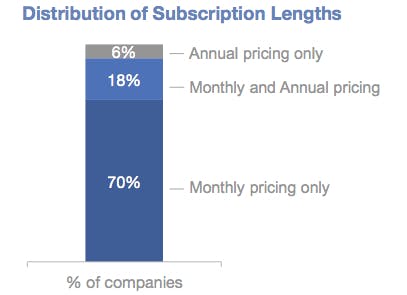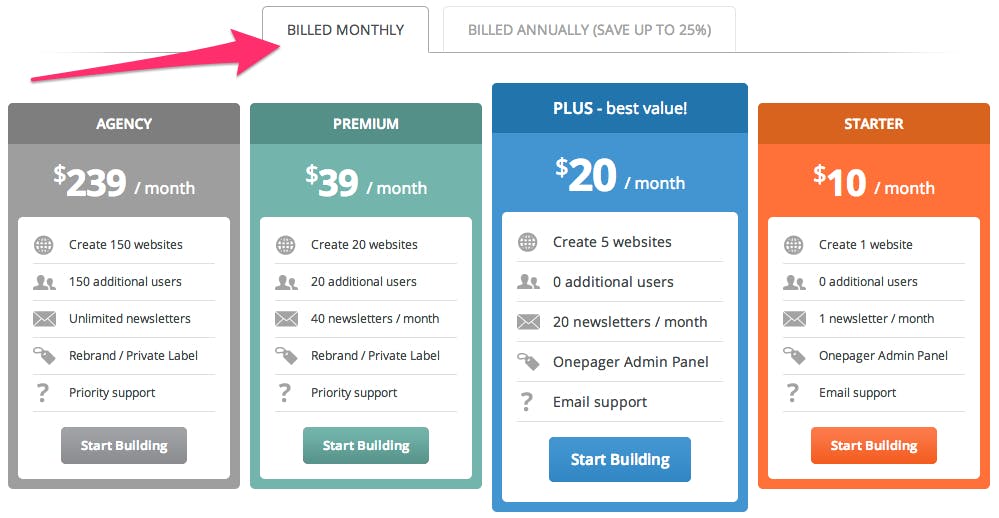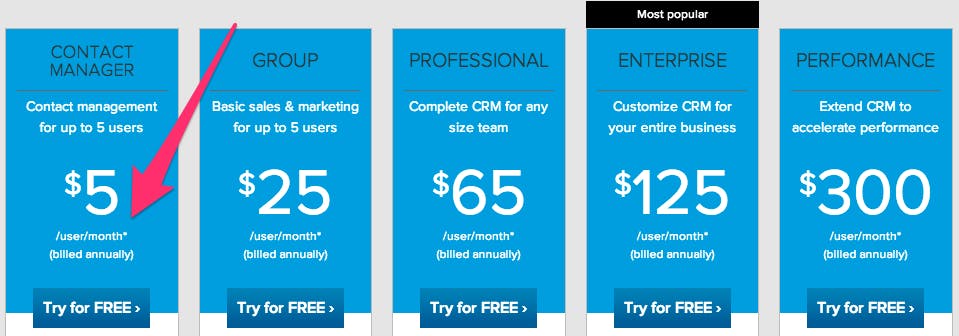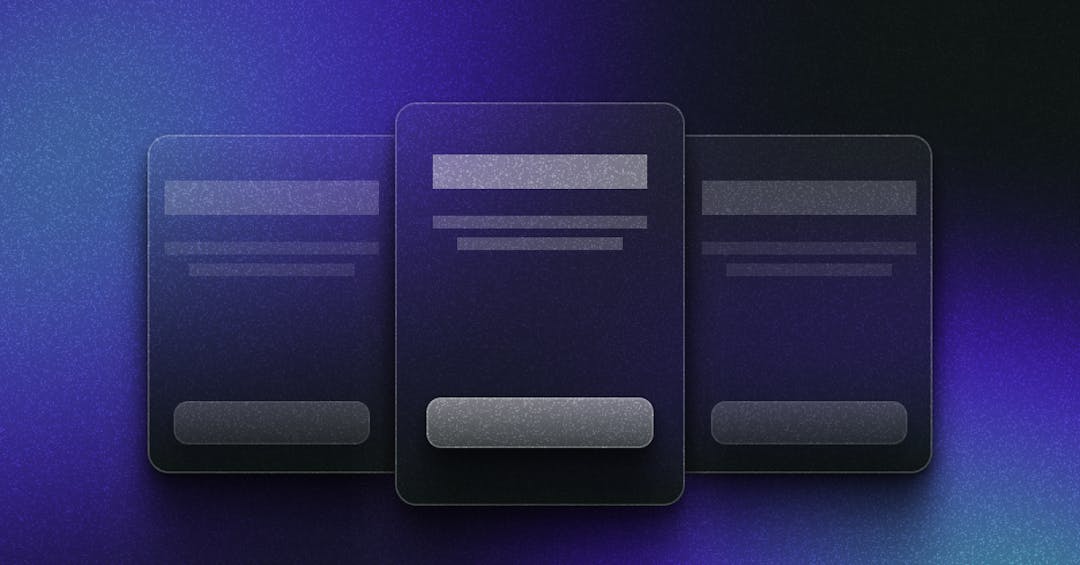The advantages of using annual billing in addition to monthly plans and how to display them both effectively on your pricing page.
Annual and monthly billing plans are common in SaaS businesses. Monthly plans work best for short-term users who need to test a service, while annual plans work better for users who are confident they’ll be using the service for a year or longer. So how should you offer them to your customers?
Monthly vs Annual Subscriptions
We're delving into monthly billing and annual billing subscriptions below, helping you to make your own informed decision on selecting the most effective pricing models for your business.
What is monthly billing?
A monthly billing subscription charges users on the same day each month for the services provided. Typically, customers are able to cancel at any point unless monthly billing terms outline otherwise.
Monthly billing: pros and cons
Monthly billing is a great way to entice new consumers towards trialling your product or service. They offer a flexible experience over a set period, without (unless specified) any fees should a customer choose to end their subscription at any point. While they're a great way to encourage new interest in your products or services, they aren't necessarily developed with long-term values in mind. It's may be harder to achieve and sustain customer retention through monthly billing initiatives.
What is annual billing?
Annual billing refers to a pricing model wherein a customer is charged the full balance for a yearly subscription — and they aren't charged during this period (providing there have been no major changes to your account, for example granting new users access to solutions).
Annual billing: pros and cons
Annual billing is a more measurable depiction of how customers value your services or solutions. Choosing an annual billing package demonstrates a clear willingness around customer retention, and it also portrays trust in your business. There are also effective ways to capitalise on having an annual subscription fee, including providing a discount on the total cost in comparison to a monthly billing 'pay-as-you-go' style plan.
Should I offer annual or monthly billing — or both?
Choosing between monthly and annual billing for your subscription pricing strategy can be complicated - but who said you had to choose? If you’ve taken a good look at our SaaS Pricing Page Blueprint eBook, you know that only 1 in 5 of the 270 SaaS companies we studied offer both monthly and annual pricing. When it comes to subscription models, most companies offer monthly plans exclusively; the lower prices appear friendlier, and the lack of a heavy commitment reduces friction for new customers.
Yet as long as the pricing structure isn’t too complex, a SaaS company can use both monthly and annual plans to boost revenue. Sure, monthly payments may be the lifeblood of your business, but annual subscriptions secure you more business upfront, increase cash flow, and reduce churn. Even a small percentage of larger contracts can have a huge impact on your bottom line.
Compromising between the two options doesn’t have to clog up your pricing page either, which is why we’re going to examine a couple company pages that keep it simple while ensuring buyers know they can sign up for bigger deals. First, let’s dive into why annual plans and cash upfront is so important to your SaaS subscription business.

Why Should I Offer Annual Subscriptions?
Weighing up your options when it comes to pricing models should certainly involve looking into the advantages of the longer, more valuable annual billing package. Here's why.
Annual billing can help to develop customer retention
Customer retention is the key to profitability in SaaS, and customers who churn out can waste a considerable portion of the cash you spend to acquire them. The flexibility and lower barrier to entry of the monthly subscription is crucial for acquiring new users, but you can’t deny that if customers bail out on your service, you won’t see the cash you need to survive, let alone grow and prosper.
Simply put, an annual plan guarantees the customer will be around for at least 12 months. That’s a huge step up in customer lifetime value, and you’ll have more time to engage with the customer and ensure implementation of the product was successful.
Annual billing makes for consistent cash flow
Annual contracts also provide an opportunity to get paid for months upfront, which will improve your cash flow and help you recover customer acquisition costs. Asking for payments in advance can be a major buzzkill for some prospects, but those who love your product might be persuaded to commit if you offer up a slight discount.
The importance of transparent terms
What’s essential to understand is that both plans benefit your business, and offering the customer a choice won’t necessarily hurt your bookings. As long as you're transparent with your pricing strategy and you have a clear way to display monthly and annual options, the flexibility will ensure you can cater to different buyers at different stages in the customer life cycle.
Demonstrating the Power to Choose
As we mentioned above, providing more than one type of subscription doesn't have to turn your pricing page into a hot mess (as long as the pricing structure isn’t too complicated already). While the number of SaaS companies currently offering annual plans might be low, more businesses are beginning to see the advantage of using discounted annual billing alongside monthly plans at full price.
Wistia: Exploring annual & monthly billing packages
One such company is Wistia, who have a gorgeous pricing page we’ve championed countless times in previous posts. From the right hand side of the page, you can click on monthly or annual pricing, and the monthly prices within each of the five paid tiers change to display the 20% discount you’ll receive if you sign up for an annual contract. The pricing is still displayed monthly, but the prices change to reveal the discount (it also says “save 20% by paying annually” above the spot where you select annual or monthly plans).
Wistia’s monthly vs annual subscription pricing example:
Monthly Billing:

Annual Billing:

What’s great about this design tactic is its simplicity – they aren’t adding much to the page, just a small switch to the right. Nothing on the page is affected except for the prices, and the customer can easily see the precise benefit of signing up for annual billing.
Another example is Onepager, a company that offers a professional website building solution for small businesses. They do something very similar to Wistia, although you’ll see the discount for an annual subscription is not consistent across the board.
Onepager: The impact of pricing strategy
On Onepager’s pricing page, there are two tabs for monthly and annual billing directly above the tiers. If you click on the annual billing tab, the prices within the tiers change in the same way as Wistia’s - to accommodate the discount. Nothing else on the page is altered. As mentioned above, the difference is in the discount, and while the annual subscriptions for the middle tiers are discounted 25%, the lowest and highest tiers are discounted less (20% and close to 17% respectively). The annual billing tab states you can “save up to 25%,” so it’s fairly clear that not all of the plans will be discounted equally.
For the record, we recommend discounting your annual subscriptions 15-20%, but it depends on your business and the price sensitivity of your customers. We’re not entirely sure how Onepager arrived at these numbers, or whether they used customer data to develop their pricing strategy, but their page definitely displays the difference in price between monthly and annual plans effectively. One click reveals the reward for loyalty and commitment, and that’s all it should take.
Salesforce.com: The importance of staying aligned with your customer
Given the impact of providing an annual plan on your recurring revenue and SaaS metrics, you may be tempted to only offer that option. After all, Salesforce, one of the most successful SaaS companies of all time, shows you monthly prices but forces you to pay annually.
Salesforce: Annual Billing (displayed monthly)

While this approach is ok in theory, it may aggravate potential buyers. Onboarding new subscribers with annual contracts is also expensive, and you’ll need a proper sales team to justify the value provided in the product if you want to lock in those bigger deals. That being said, no one wants their customers to bail out after a few months either. Do what’s best for you - just make sure your pricing structure aligns with the value your customers are looking for in your service. If you have a range of customers you can serve, providing both options can be a profitable, happy medium for your business.
Want to Learn More about annual and monthly billing plans?
Each company and pricing page is unique, so if you want a detailed analysis of your own pricing strategy, feel free to sign up for a free pricing audit with an expert here on the team.


